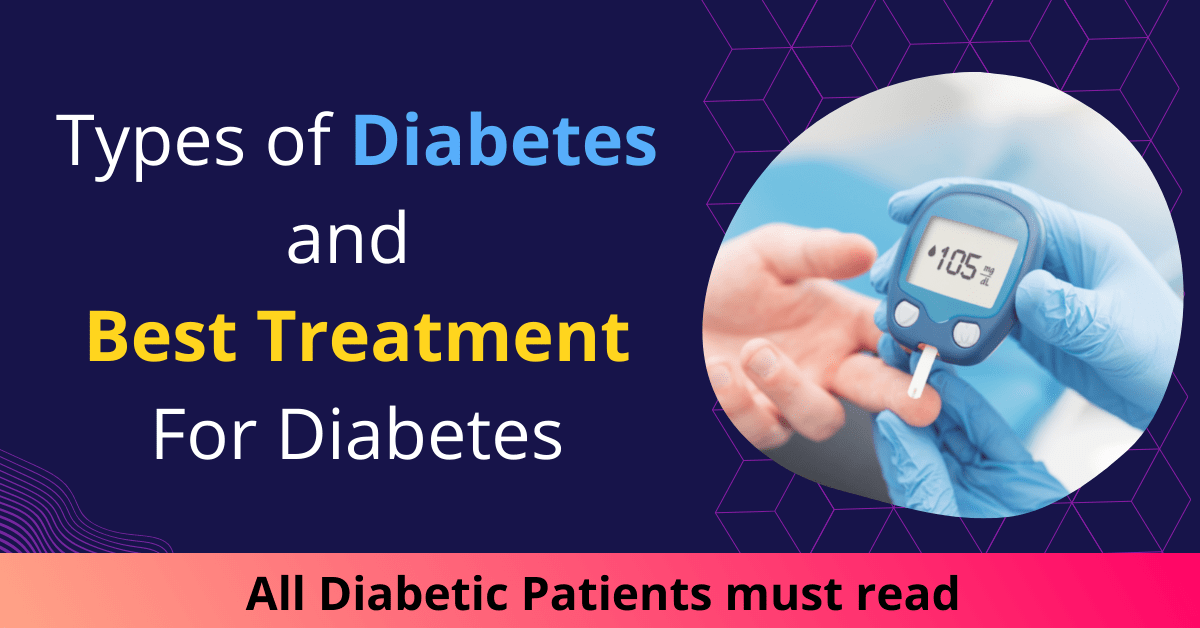What is Diabetes?
Diabetes is a condition where the body’s capacity to process blood glucose, also known as blood sugar, is impaired. There are various forms of diabetes, each with its treatment options.
When your blood glucose, commonly known as blood sugar, is too high, you are at risk of diabetes. However, high blood glucose might cause health problems. Gestational, type 1, and type 2 diabetes are three main types of diabetes.
from here know more about Types of diabetes and the Best Treatment For Diabetes
In Other words, Diabetes is a group of disorders characterized by issues with the insulin hormone. Usually, the pancreatic (an organ located behind the stomach) produces insulin to help store and use fat and sugar from the diet. When one of the following occurs, diabetes develops:
- When such pancreas is unable to generate an insulin
- Whenever the pancreas generates only a tiny dose of insulin
- Insulin resistance occurs when the body does not respond effectively to insulin.
Insulin’s Function in Diabetes
To recognize why insulin is essential in diabetes, you should first know how the body uses food for energy. Millions of cells make up your body. These cells require elementary food to generate power in the body.
Most of your food is subdivided into a simple sugar called “glucose” once you eat or drink.
The glucose is transferred through the bloodstream to your body’s cells, where it can be utilized to give some of the energy required for daily tasks.
The pancreas is continuously releasing small amounts of insulin. The hormone insulin tightly regulates the level of glucose in your blood system. Whenever glucose level in your blood reaches a certain threshold, the pancreas produces more insulin to move more glucose into your cells. As a result of this, Blood glucose levels fall.
To prevent your blood glucose levels from falling too low (hypoglycemia or low blood sugar), your body signifies you to eat and discharges some glucose from the liver’s storage.
Patients with diabetes often do not produce insulin, or their cells are resistant to insulin, resulting in high blood sugar levels. After an overnight fast, diabetes is defined as a blood glucose level of 126 milligrams per deciliter (mg/dL) or above (not eating anything).
Types of diabetes and Best Treatment For Diabetes
Type 1 diabetes
Type 1 diabetes, also termed insulin-dependent diabetes or juvenile diabetes, is a chronic illness in which the pancreas produces little or no insulin. Insulin is a hormone that enables sugar (glucose) into cells for energy production.
Type 1 diabetes can be caused by various factors, including diet, genetics & viruses. Although type 1 diabetes most commonly appears in youth or adolescence, it can also develop in adulthood.
Despite the ongoing study, there is no treatment for type 1 diabetes. Treatment focuses on Blood sugar control with medication, food, and lifestyle changes to avoid such problems.
Controlling blood sugar levels can help persons with type 1 diabetes avoid significant problems. Among the most prevalent issues are:
- Metabolic acidosis
- Nerve injury
- Skin infection risk is higher.
- Difficulties with the eyes
- Cardiac problems
- Foot issues, such as numbness
- Problems with the kidneys
- Blood pressure problems
Type 2 diabetes
Type 2 diabetes patients do not create or use insulin effectively. Type 2 is the most common type of diabetes, as per the National Institute of Diabetes and Digestive and Kidney Diseases (NIDDK), and has strong connections to overweight.
An individual experiencing type 2 diabetes may or may not require insulin. Medication and improvements in exercise and diet can often help manage the condition.
Type 2 diabetes can affect anyone, including children and adults. The following are the most common risk factors for the development of type 2 diabetes:
- 45 years of age or older
- Obesity
- family background
Many persons having type 2 diabetes can control their weight, eat a healthy diet, and exercise regularly. Others may require insulin or a tablet to aid their bodies in using insulin more effectively. The HbA1C test diagnoses diabetes in patients.
Doctors can often predict the beginning of type 2 diabetes before the disease shows itself. Pre-diabetes is when a person’s blood sugar levels are higher than usual but have not yet been high enough to be diagnosed with type 2 diabetes.
Prediabetes
Prediabetes, also known as borderline diabetes, is a condition in which a person’s blood sugar levels are high but not high enough to be diagnosed with diabetes. A person must meet the following criteria to be diagnosed with prediabetes by a doctor:
- 140–199 milligrams per deciliter (mg/dl) glucose tolerance
- Glycosylated hemoglobin testing results of 5.7–6.4%
- Between 100 and 125 mg/dl of fasting blood sugar
Individuals with this condition are at a higher risk of developing type 2 diabetes, but they don’t usually show signs of the disease.
The signs and symptoms of prediabetes and type 2 diabetes are nearly identical. Some Among them are:
- Excessive weight
- Diabetes in the family
- High blood pressure in the past
- Having polycystic ovary syndrome (PCOS) in the past
- Being older than 45 years
- Having a physically inactive lifestyle
Gestational diabetes
Obese women are more likely to acquire the disease during pregnancy. An individual’s insulin sensitivity decreases during pregnancy, leading to gestational diabetes. Each year, between 2–10 percent of pregnancies result in gestational diabetes, according to the Centers for Disease Control and Prevention (CDC).
Pregnancy triggers gestational diabetes. Hormonal changes can harm insulin’s capacity to operate correctly during pregnancy.
Pregnant women over 25 years old, overweight before childbirth, have a family history of diabetes or are black, Native American, Hispanic or Asian have a higher risk of developing gestational diabetes.
Individuals can take measures to manage their disease during pregnancy. Among them are:
- Keeping active
- Evaluating the fetus’s growth and development
- Improving their eating habits
- keeping track of blood sugar levels
Gestational diabetes raises a woman’s chances of developing high blood pressure during pregnancy. This can result in:
- Premature delivery
- Higher birth weight
- Blood sugar problems with the newborn which usually resolve within a few days
- Greater risk of type 2 diabetes in the newborn later in life
What Is the Treatment for Diabetes?
Diabetes cannot be cured, but it can be monitored and operated on. The objectives of diabetes therapy are to:
- Balance your food intake with medicine and activity to keep your blood sugar levels close to normal.
- By avoiding added sugars and processed carbohydrates and minimizing fat and cholesterol, you can keep your blood cholesterol and triglyceride (lipid) levels close to normal.
- Maintain a healthy blood pressure level. It will help if you keep your blood pressure below 130/80.
- Diabetes-related health problems can be delayed or even prevented.
You have the path to controlling diabetes by
- Plan your meals and stick to a well-balanced diet.
- Regularly exercising
- Taking medicine as recommended and sticking to the instructions on when and how to take it
- Attending meetings with your healthcare practitioners and completing laboratory tests as recommended by your physician
Thanks for reading Types of diabetes and best treatment for diabetes




